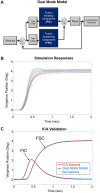A pilot study of disparity vergence and near dissociated phoria in convergence insufficiency patients before vs. after vergence therapy
- PMID: 26283944
- PMCID: PMC4515554
- DOI: 10.3389/fnhum.2015.00419
A pilot study of disparity vergence and near dissociated phoria in convergence insufficiency patients before vs. after vergence therapy
Abstract
Purpose: This study examined the relationship between the near dissociated phoria and disparity vergence eye movements. Convergence insufficiency (CI) patients before vergence therapy were compared to: (1) the same patients after vergence therapy; and (2) binocularly normal controls (BNC).
Methods: Sixteen subjects were studied-twelve BNC and four with CI. Measurements from the CI subjects were obtained before and after 18 h of vergence eye movement therapy. The near dissociated phoria was measured using the flashed Maddox rod technique. Vergence responses were stimulated from 4° symmetrical disparity vergence step stimuli. The peak velocity of the vergence response and the magnitude of the fusion initiating component (FIC) from an independent component analysis (ICA) were calculated. A linear regression analysis was conducted studying the vergence peak velocity as a function of the near dissociated phoria where the Pearson correlation coefficient was computed.
Results: Before vergence therapy, the average with one standard deviation FIC magnitude of convergence responses from CI subjects was 0.29° ± 0.82 and significantly less than the FIC magnitude of 1.85° ± 0.84 for BNC (p < 0.02). A paired t-test reported that the FIC and near dissociated phoria before vergence therapy for CI subjects significantly increased to 1.49° ± 0.57 (p < 0.04) and became less exophoric to 3.5Δ ± 1.9 exo (p < 0.02) after vergence therapy. A significant correlation (r = 0.87; p < 0.01) was observed between the near dissociated phoria and the vergence ratio of convergence peak velocity divided by divergence peak velocity.
Conclusion: The results have clinical translational impact in understanding the mechanism by which vergence therapy may be changing the vergence system leading to a sustained reduction in visual symptoms.
Keywords: convergence; convergence insufficiency; divergence; fusion initiating component; near dissociated phoria; vergence therapy.
Figures




References
-
- Alvarez T. L., Jaswal R., Gohel S., Biswal B. B. (2014). Functional activity within the frontal eye fields, posterior parietal cortex and cerebellar vermis significantly correlates to symmetrical vergence peak velocity: an ROI-based, fMRI study of vergence training. Front. Integr. Neurosci. 8:50. 10.3389/fnint.2014.00050 - DOI - PMC - PubMed
-
- Alvarez T. L., Semmlow J. L., Yuan W. (1998). Closely spaced, fast dynamic movements in disparity vergence. J. Neurophysiol. 79, 37–44. - PubMed
Grants and funding
LinkOut - more resources
Full Text Sources
Other Literature Sources
Miscellaneous

